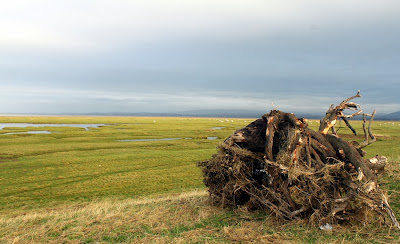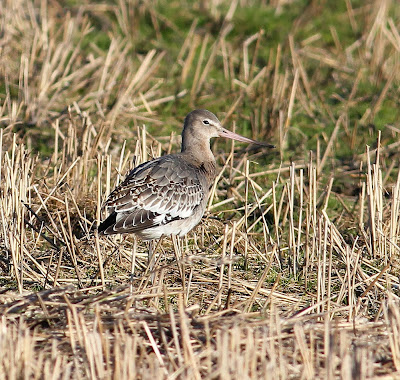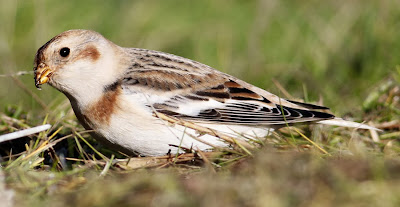My thanks to Mary Howell Cromer over in Kentucky USA, a fellow blogger who brought the article below to my attention.
From The Washington Post 15th December 2013 - The Washington Post
GREAT YARMOUTH, England — Garry Bagnell is cruising down an English country road when his beeper lights up with a bulletin. A shorelark — a distinctive bird with yellow and black markings — took a wrong turn somewhere over Norway and is getting its bearings on a beach an hour’s drive north. Time to step on the gas.
Britain’s wild world of competitive bird-watching can be a truly savage domain, a nest of intrigue, fierce rivalries and legal disputes.
“I need that bird, I need it,” said Bagnell, a 46-year-old accountant and hard-core practitioner of British twitching, or extreme — and extremely competitive — bird-watching. “When a bird you haven’t seen drops, you’ve got to chase it. That’s going to bring me up to 300 [different species] spotted for the year. You don’t understand how competitive this is. For some people, this is life and death.”
Beyond these shores, the world of bird-watching may be a largely gentle place ruled by calm, binocular-toting souls who patiently wait for their reward. But in Britain, it can be a truly savage domain, a nest of intrigue, fierce rivalries and legal disputes. Fluttering somewhere between sport and passion, it can leave in its path a grim tableau of ruined marriages, traffic chaos and pride, both wounded and stoked.
This is the wild, wild world of British twitching.
Britain isn’t the only place that has hatched a culture of fierce bird-watching. In the United States, book-turned-Hollywood-film “The Big Year” chronicled the quest of three men vying in long-held American competitions to spot the most number of species in a single year. Nevertheless, observers say the intensity of the rivalries and the relative size of the twitching community here — which numbers in the thousands — have singled out British birders as some of the most relentless in the world.
One of the fiercest rivalries, for instance, pits Bagnell’s former mentor and now nemesis, Lee Evans, against 41-year-old grocer Adrian Webb. Evans, 53, dubs himself the “judge, jury and executioner” of British bird-watching and keeps his own twitcher rankings.
To take on the master, Webb took 12 months off from work in 2000, spending $22,000 and driving 88,000 miles to break Evans’s record of 386 species of birds seen on the British Isles in one year. They trash-talk on the birding circuit like prize fighters.
Evans “is a bit of a strange bloke,” said Webb, who is known to drop his grocer’s apron and turn on a dime to chase a rare bird and claims to have broken Evans’s record in 2000. “He doesn’t like people who he thinks are a threat to him. If someone has seen more birds than him, he doesn’t like it. If someone sees a bird that he hasn’t, he doesn’t like that, either.”
Evans — a figure so polarizing on the birding circuit that his name is routinely smeared on rivals’ blogs and in online forums — does not recognize Webb’s claim to the title.
Over the years, Evans has wracked up big legal bills defending himself against allegations of slander for allegedly undercounting the tallies of rivals and questioning whether they’ve actually seen all the birds they claim.
He dismissively calls Webb a “checkbook birder” — one of those who will spend any sum to reach birds spotted even on distant islands miles off the British coast. Evans also insists that he has been the victim of underhanded tricks, citing an incident when he was racing to see a rare bird in Scotland. He had lined up a plane to take him to a sighting on a remote island only to find that a group of rival birders had stuffed the palm of his pilot “with a few extra quid” to take them instead.
“In America, bird-watching is still mostly a pastime,” said Evans, who is on his fourth marriage and blames his divorces partly on his obsession with twitching. “But in Britain, bird-watching can be bitter. It can be real nasty business.”
A term coined in the 1960s to describe the jaw-rattling sound of chasing after rare birds on rumbling motorbikes, “twitchers” are narrowly defined as bird-watchers willing to drop everything to chase a sighting. More broadly, it includes those who make their way to see a bird within a few days of an urgent bulletin.
Such bulletins are typically sent out by services such as the Rare Bird Alert, which obtains its information in real time from a vast network of bird-watchers across Britain. Once notified of a sighting, the service issues urgent messages to its 21,000 subscribers via pay-by-the-month pagers and smartphone apps.
In one of dozens of similar scenes of “twitcher madness” here, local police were forced to cordon off streets after hundreds of desperate bird-watchers descended on a suburban home in Hampshire last year when a rare Spanish Sparrow fluttered into somebody’s garden.
For a mostly male sport with an average age over 50, however, twitching can also tempt fate. In October, a top British twitcher, Tim Lawman, had a heart attack while on the trail of a Radde’s warbler in Hampshire. “It was a new bird for him, and in all the excitement of rushing to see it, he just keeled over and died,” Evans said.
A popular smartphone app to help British birders is being advertised as an essential tool when “there have even been recent cases of violent clashes between bird watchers as people desperately try to get the very best spots.” In 2009, Bagnell said, he and other twitchers were aghast when two elderly rivals on the circuit went for each other’s throats. “One was saying he’d seen a bird, and the other said he didn’t believe him,” Bagnell said.
Though most twitchers are bird-lovers, the sport is mostly about the chase. Bagnell, for instance, drove 90 minutes and searched the ground for a half-hour before he spotted the coy shorelark in beach scrub. He eyed it for a few moments before tweeting his find, then moved on. “I’ve got another bird to get three hours away,” he said.
The most unfortunate twitchers race many miles to spot a bird only to find that their flighty subjects have flown off — a bummer known in the twitching world as a “dip.” One of the most infamous dips came as Webb pursued a long-tailed shrike in the Outer Hebrides off mainland Scotland. The boat he and 12 others had hired died in choppy waters, forcing a daring rescue by Her Majesty’s Coastguard. “We were worried for our lives for a bit, but we were more worried about not seeing this bird,” he said.
Within the world of twitching, there are countless rankings — lifetime lists, annual lists, semiofficial lists, slightly more official lists. Such rankings are partly predicated on evidence. When you saw that velvet scoter wading in Wales, were there witnesses? How about photographs? If not, claims all come down to trust.
Many see twitching as an outcrop of the British fascination with “spotting” things — most notoriously, trainspotting, a hobby that involves the obsessive pursuit of seeing as many locomotives with your own eyes as humanly possible. But others say it may simply be a case of boys who refuse to grow up.
“Years ago, British boys used to spend their childhoods collecting birds’ eggs — now you wouldn’t dream of doing such a thing,” said Brian Egan, manager of the Rare Bird Alert. “But what they can do as adults is chase sightings of rare birds. So that’s what they do.”
If you need a further laugh, log onto the Washington Post page to read some of the follow-up comments. The Washington Post
More bird watching madness from Another Bird Blog soon.

















































.jpg)












